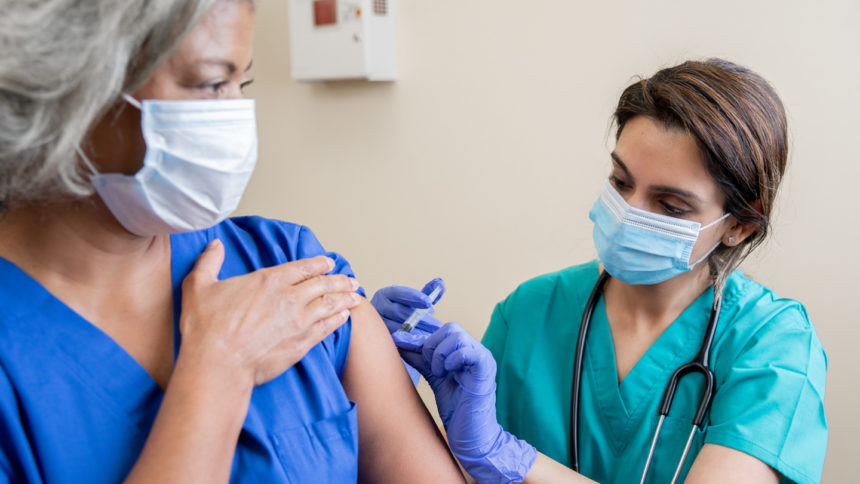
Policymakers should rethink their “stagnant” approach to booster shots, argue the researchers behind a new, first-of-its kind national study linking COVID-19 vaccination of nursing home staff to significantly improved resident outcomes over time.
As little as a 10-percentage point increase in staff vaccinations delivered lower weekly case counts and deaths among residents in the first months after shots became available, according to an analysis of federal vaccination data from more than 15,000 nursing homes. The landmark study was published Thursday in JAMA Network Open.
University of Chicago researchers calculated that, over the course of a year, a 10-point vaccination increase would have prevented 102.9 cases per 1,000 residents, 15.6 deaths per 1,000 residents and approximately 21,000 staff infections nationwide.
Extrapolating those results to all nursing homes in the US would have resulted in more than 20,000 fewer nursing home resident deaths in a year, co-author R. Tamara Konetzka, PhD, Louis Block Professor of Public Health Sciences at the University of Chicago, told McKnight’s Long-Term Care News Wednesday.
But the study also found that the staff-to-resident benefits waned as the omicron variant took hold in late 2021. No rules mandating that workers have updated COVID shots were in place at that time, nor are they today.
“Current vaccination rates would never have been achieved without [a] mandate,” said Konetzka, who co-authored the paper with Soham Sinha, a PhD student in health economics at The University of Chicago. “As the pandemic evolves to include newer, more infectious strains of the virus, evolving policies in the form of extending mandates for booster doses for staff in nursing homes will be critical to prevent a return to the early days of the pandemic when mounting nursing home deaths seemed almost inevitable.”
Vaccines didn’t stop working
The first US COVID booster shot became available in September 2021. But with its then-proposed mandate under intense public and legal scrutiny, the Centers for Medicare & Medicaid Services did not dictate additional shots for healthcare workers. Even after the mandate was upheld by the Supreme Court in January 2022 — and as additional boosters, including a bivalent shot, were formulated to protect against more variants — federal regulators never required healthcare workers get more than their initial COVID vaccine.
In an email to McKnight’s, Sinha said that the mandated initial regimen (two doses of Pfizer, two doses of Moderna, or one dose of the J&J vaccine) “no longer constitutes appropriately sufficient vaccination.”
“It’s not that the vaccines stopped working, but that what we think of and mandate as sufficient vaccination needs to evolve along with the disease variants,” Sinha said. He pointed to a recent study of nursing home residents that found a lower risk of COVID infection and hospitalization after boosters were widely adopted by two large US nursing home systems after omicron took hold.
But as of Dec. 11, the last date for which data was available from CMS, just 22.1% of nursing home staff nationally were considered up-to-date on boosters for which they were eligible.
“Although the original vaccination campaign in nursing homes was highly successful in bringing down case and death rates, and mandates led to staff vaccination rates exceeding the thresholds we found for high effectiveness, these policies cannot remain stagnant,” the authors wrote in their paper.
New evidence for policymakers
The researchers said ongoing policy around staff vaccinations has been made “in the absence of a robust evidence base,” because no other studies showing the effect of nursing home staff vaccinations on resident outcomes had been as broad or as clear. Their findings, they wrote, fill a key data gap by providing estimates on the magnitude to which increasing staff vaccination rates over time were associated with reduced cases and deaths.
Regarding the initial vaccine series, the study found protective benefits for residents kicked in after 30% of staff were vaccinated, with the size of benefits increasing with higher vaccination rates. Steeper decreases for cases and deaths among residents and cases among staff were observed at staff vaccination levels of 60% and 80%. The biggest improvements were seen in the resident death and staff case categories.
The analysis controlled for other factors, including county-level prevalence, resident vaccination rates and staffing hours. The highest rates of staff vaccinations were associated with protection to residents and staff even with COVID surges in the community.
For purposes of the study, the researchers defined the omicron wave period as Dec. 5, 2021, to Jan. 30, 2022, and compared that to vaccination rates and effects seen prior to that window.
While this study puts increased pressure on CMS to strengthen its vaccine mandate, other efforts are afoot to have the federal government rescind its rule for healthcare workers.




